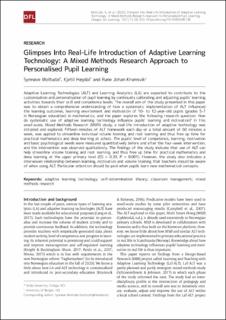| dc.contributor.author | Moltudal, Synnøve | |
| dc.contributor.author | Høydal, Kjetil L | |
| dc.contributor.author | Krumsvik, Rune Johan | |
| dc.date.accessioned | 2021-03-09T11:33:45Z | |
| dc.date.available | 2021-03-09T11:33:45Z | |
| dc.date.created | 2020-03-03T16:14:19Z | |
| dc.date.issued | 2020 | |
| dc.Published | Designs for Learning. 2020, 12 13-28. | |
| dc.identifier.issn | 1654-7608 | |
| dc.identifier.uri | https://hdl.handle.net/11250/2732351 | |
| dc.description.abstract | Adaptive Learning Technologies (ALT) and Learning Analytics (LA) are expected to contribute to the customisation and personalisation of pupil learning by continually calibrating and adjusting pupils’ learning activities towards their skill and competence levels. The overall aim of the study presented in this paper was to obtain a comprehensive understanding of how a systematic implementation of ALT influenced the learning outcomes, learning environment and motivation of 10- to 12-year-old pupils (grades 5–7 in Norwegian education) in mathematics, and the paper explores the following research question: How do systematic use of adaptive learning technology influence pupils’ learning and motivation? In this small-scale, Mixed Methods Research (MMR) study, a real-life introduction of adaptive technology was initiated and explored. Fifteen minutes of ALT homework each day or a total amount of 60 minutes a week, was applied to streamline individual volume training and root learning and thus free up time for practical mathematics and deep learning at school. The pupils’ level of competence, learning, motivation and basic psychological needs were measured quantitatively before and after the four-week intervention, and the intervention was observed qualitatively. The findings of the study indicate that use of ALT can help streamline volume training and root learning, and thus free up time for practical mathematics and deep learning at the upper primary level (ES = 0.39, P = 0.001). However, the study also indicates a interwoven relationship between learning, motivation and volume training that teachers should be aware of when using ALT. Particular attention should be paid when pupils learn new mathematical concepts. | en_US |
| dc.language.iso | eng | en_US |
| dc.publisher | Stockholm University Press | en_US |
| dc.rights | Navngivelse 4.0 Internasjonal | * |
| dc.rights.uri | http://creativecommons.org/licenses/by/4.0/deed.no | * |
| dc.title | Glimpses Into Real-Life Introduction of Adaptive Learning Technology: A Mixed Methods Research Approach to Personalised Pupil Learning | en_US |
| dc.type | Journal article | en_US |
| dc.type | Peer reviewed | en_US |
| dc.description.version | publishedVersion | en_US |
| dc.rights.holder | Copyright 2020 The Author(s). | en_US |
| cristin.ispublished | true | |
| cristin.fulltext | original | |
| cristin.qualitycode | 1 | |
| dc.identifier.doi | http://doi.org/10.16993/dfl.138 | |
| dc.identifier.cristin | 1799414 | |
| dc.source.journal | Designs for Learning | en_US |
| dc.source.40 | 12 | |
| dc.source.pagenumber | 13-28 | en_US |
| dc.identifier.citation | Designs for Learning. 2020, 12 (1), 13–28. | en_US |
| dc.source.volume | 12 | en_US |
| dc.source.issue | 1 | en_US |

